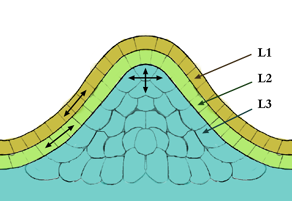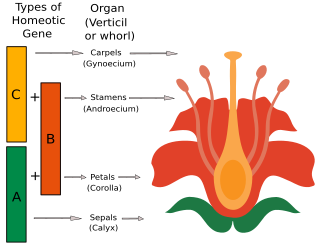
A transposable element is a nucleic acid sequence in DNA that can change its position within a genome, sometimes creating or reversing mutations and altering the cell's genetic identity and genome size. Transposition often results in duplication of the same genetic material. In the human genome, L1 and Alu elements are two examples. Barbara McClintock's discovery of them earned her a Nobel Prize in 1983. Its importance in personalized medicine is becoming increasingly relevant, as well as gaining more attention in data analytics given the difficulty of analysis in very high dimensional spaces.

In cell biology, the meristem is a type of tissue found in plants. It consists of undifferentiated cells capable of cell division. Cells in the meristem can develop into all the other tissues and organs that occur in plants. These cells continue to divide until they become differentiated and lose the ability to divide.

Antirrhinum is a genus of plants commonly known as dragon flowers or snapdragons because of the flowers' fancied resemblance to the face of a dragon that opens and closes its mouth when laterally squeezed. They are also sometimes called toadflax or dog flower. They are native to rocky areas of Europe, the United States, Canada, and North Africa. Antirrhinum species are widely used as ornamental plants in borders and as cut flowers.

Floral symmetry describes whether, and how, a flower, in particular its perianth, can be divided into two or more identical or mirror-image parts.
A transposase is any of a class of enzymes capable of binding to the end of a transposon and catalysing its movement to another part of a genome, typically by a cut-and-paste mechanism or a replicative mechanism, in a process known as transposition. The word "transposase" was first coined by the individuals who cloned the enzyme required for transposition of the Tn3 transposon. The existence of transposons was postulated in the late 1940s by Barbara McClintock, who was studying the inheritance of maize, but the actual molecular basis for transposition was described by later groups. McClintock discovered that some segments of chromosomes changed their position, jumping between different loci or from one chromosome to another. The repositioning of these transposons allowed other genes for pigment to be expressed. Transposition in maize causes changes in color; however, in other organisms, such as bacteria, it can cause antibiotic resistance. Transposition is also important in creating genetic diversity within species and generating adaptability to changing living conditions.

The ABC model of flower development is a scientific model of the process by which flowering plants produce a pattern of gene expression in meristems that leads to the appearance of an organ oriented towards sexual reproduction, a flower. There are three physiological developments that must occur in order for this to take place: firstly, the plant must pass from sexual immaturity into a sexually mature state ; secondly, the transformation of the apical meristem's function from a vegetative meristem into a floral meristem or inflorescence; and finally the growth of the flower's individual organs. The latter phase has been modelled using the ABC model, which aims to describe the biological basis of the process from the perspective of molecular and developmental genetics.
Tn10 is a transposable element, which is a sequence of DNA that is capable of mediating its own movement from one position in the DNA of the host organism to another. There are a number of different transposition mechanisms in nature, but Tn10 uses the non-replicative cut-and-paste mechanism. The transposase protein recognizes the ends of the element and cuts it from the original locus. The protein-DNA complex then diffuses away from the donor site until random collisions brings it in contact with a new target site, where it is integrated. To accomplish this reaction the 50 kDa transposase protein must break four DNA strands to free the transposon from the donor site, and perform two strand exchange reactions to integrate the element at the target site. This leaves two strands unjoined at the target site, but the host DNA repair proteins take care of this. The target site selection is essentially random, but there is a preference for the sequence 5'-GCTNAGC-3'. The 6-9 base pairs that flank the sequence also influence selection of the insertion site.

Antirrhinum majus, the common snapdragon, is a species of flowering plant belonging to the genus Antirrhinum. The plant was placed in the family Plantaginaceae following a revision of its prior classical family, Scrophulariaceae.
The MADS box is a conserved sequence motif. The genes which contain this motif are called the MADS-box gene family. The MADS box encodes the DNA-binding MADS domain. The MADS domain binds to DNA sequences of high similarity to the motif CC[A/T]6GG termed the CArG-box. MADS-domain proteins are generally transcription factors. The length of the MADS-box reported by various researchers varies somewhat, but typical lengths are in the range of 168 to 180 base pairs, i.e. the encoded MADS domain has a length of 56 to 60 amino acids. There is evidence that the MADS domain evolved from a sequence stretch of a type II topoisomerase in a common ancestor of all extant eukaryotes.
Superman is a plant gene in Arabidopsis thaliana, that plays a role in controlling the boundary between stamen and carpel development in a flower. It is named for the comic book character Superman, and the related genes kryptonite (gene) and clark kent were named accordingly. It encodes a transcription factor. Homologous genes are known in the petunia and snapdragon, which are also involved in flower development, although in both cases there are important differences from the functioning in Arabidopsis. Superman is expressed early on in flower development, in the stamen whorl adjacent to the carpel whorl. It interacts with the other genes of the ABC model of flower development in a variety of ways.

The mobilome is the entire set of mobile genetic elements in a genome. Mobilomes are found in eukaryotes, prokaryotes, and viruses. The compositions of mobilomes differ among lineages of life, with transposable elements being the major mobile elements in eukaryotes, and plasmids and prophages being the major types in prokaryotes. Virophages contribute to the viral mobilome.
Agamous (AG) is a homeotic gene and MADS-box transcription factor from Arabidopsis thaliana. The TAIR AGI number is AT4G18960.

Detlef Weigel is a German American scientist working at the interface of developmental and evolutionary biology.
In genetic engineering, transposon tagging is a process where transposons are amplified inside a biological cell by a tagging technique. Transposon tagging has been used with several species to isolate genes. Even without knowing the nature of the specific genes, the process can still be used.

Enrico Sandro Coen is a British biologist who studies the mechanisms used by plants to create complex and varied flower structures. Coen's research has aimed to define the developmental rules that govern flower and leaf growth at both the cellular level and throughout the whole plant to better understand evolution. He has combined molecular, genetic and imaging studies with population and ecological models and computational analysis to understand flower development.
Ac/Ds transposable controlling elements was the first transposable element system recognized in maize. The Ac Activator element is autonomous, whereas the Ds Dissociation element requires an Activator element to transpose. Ac was initially discovered as enabling a Ds element to break chromosomes. Both Ac and Ds can also insert into genes, causing mutants that may revert to normal on excision of the element. The phenotypic consequence of Ac/Ds transposable element includes mosaic colors in kernels and leaves in maize.

Transposition is the process by which a specific genetic sequence, known as a transposon, is moved from one location of the genome to another. Simple, or conservative transposition, is a non-replicative mode of transposition. That is, in conservative transposition the transposon is completely removed from the genome and reintegrated into a new, non-homologous locus, the same genetic sequence is conserved throughout the entire process. The site in which the transposon is reintegrated into the genome is called the target site. A target site can be in the same chromosome as the transposon or within a different chromosome. Conservative transposition uses the "cut-and-paste" mechanism driven by the catalytic activity of the enzyme transposase. Transposase acts like DNA scissors; it is an enzyme that cuts through double-stranded DNA to remove the transposon, then transfers and pastes it into a target site.

Didier Trono is a Swiss virologist and a professor at the École Polytechnique Fédérale de Lausanne (EPFL). He is known for his research on virus-host interactions and the development of lentiviral vectors for gene therapy.
Iva Susan Greenwald is an American biologist who is Professor of Cell and Molecular Biology at Columbia University. She studies cell-cell interactions and cell fate specification in C. elegans. She is particularly interested in LIN-12/Notch proteins, which is the receptor of one of the major signalling systems that determines the fate of cells.

Paula McSteen is a scientist known for her research on plant genetics. In 2020 she was elected a fellow of the American Association for the Advancement of Science.











